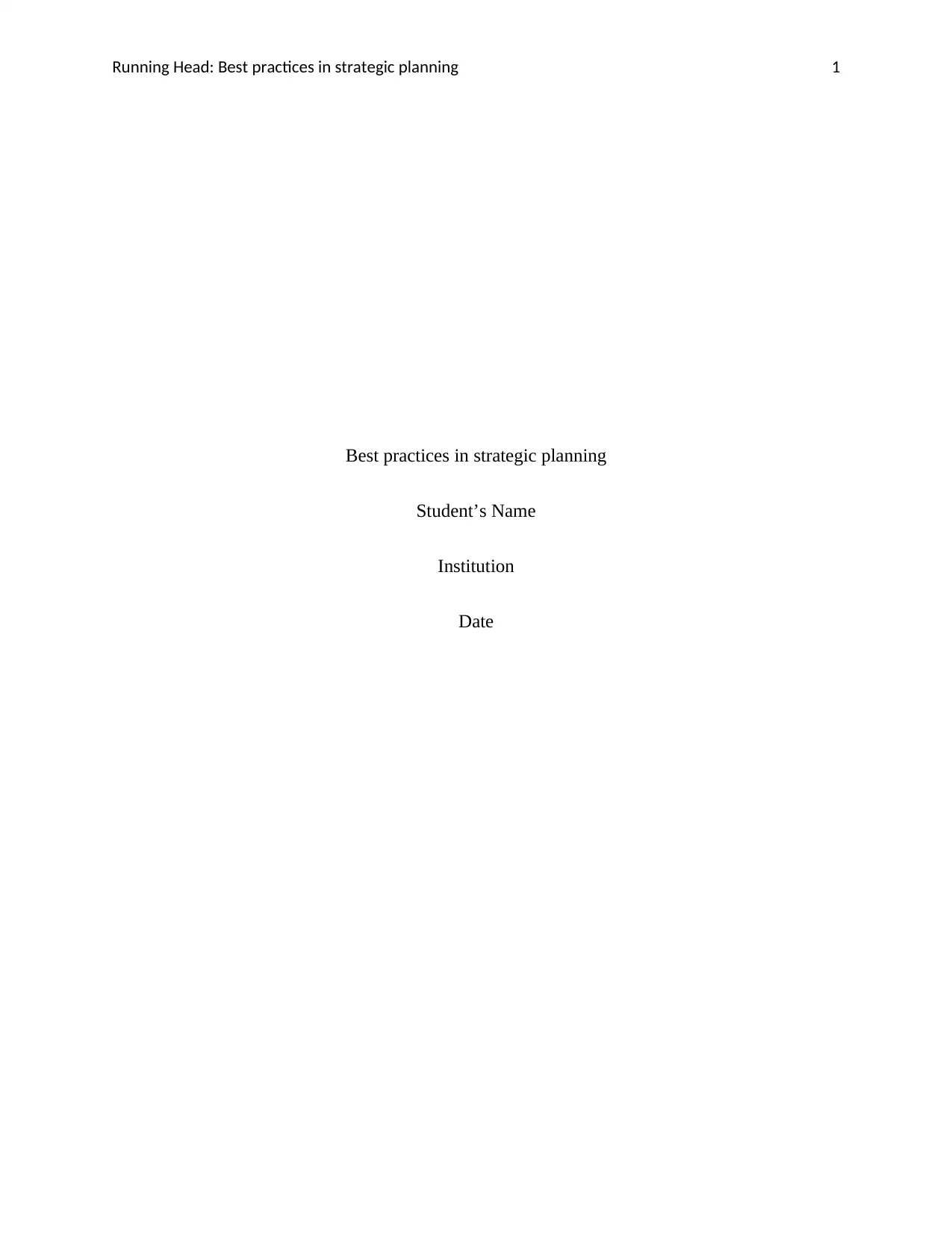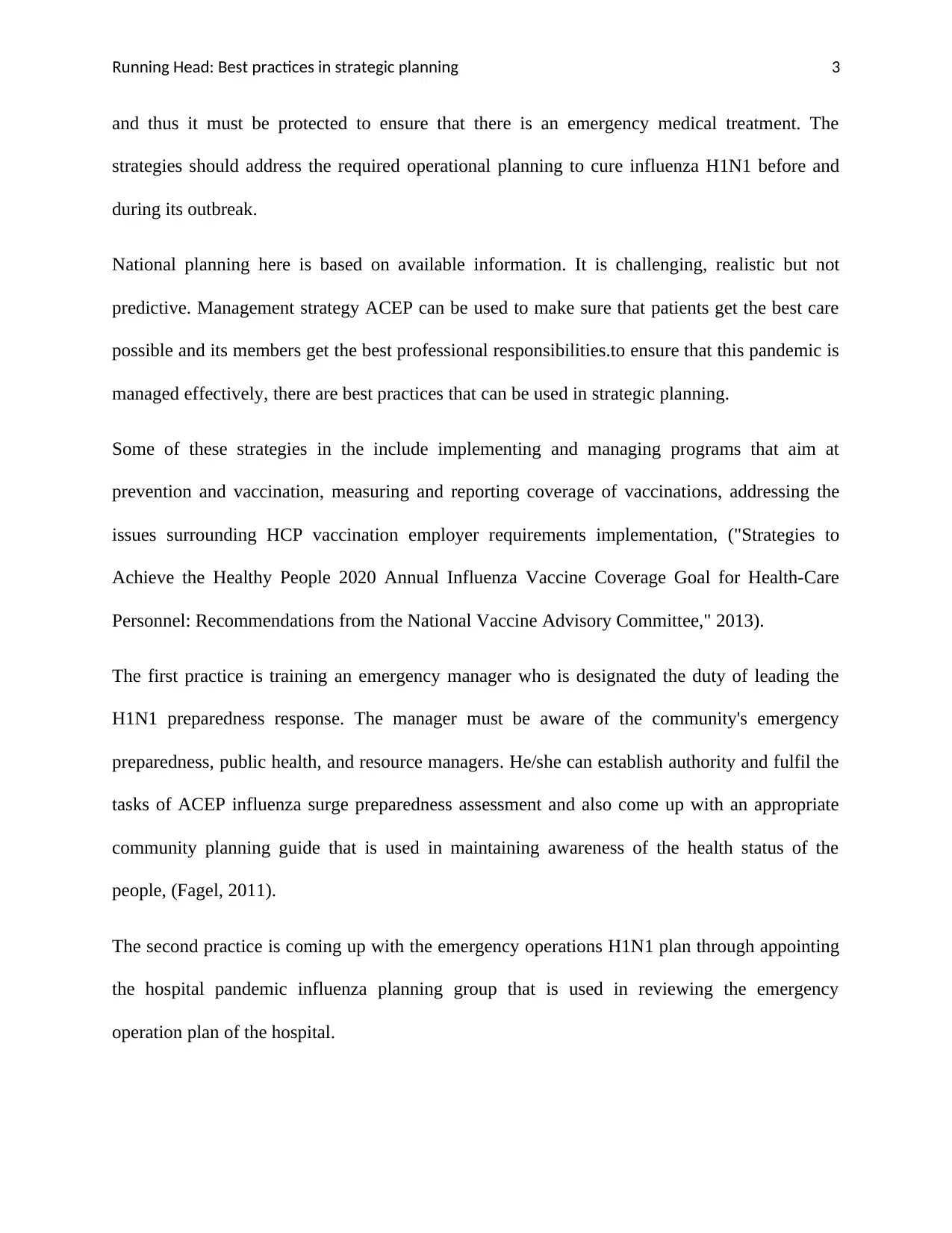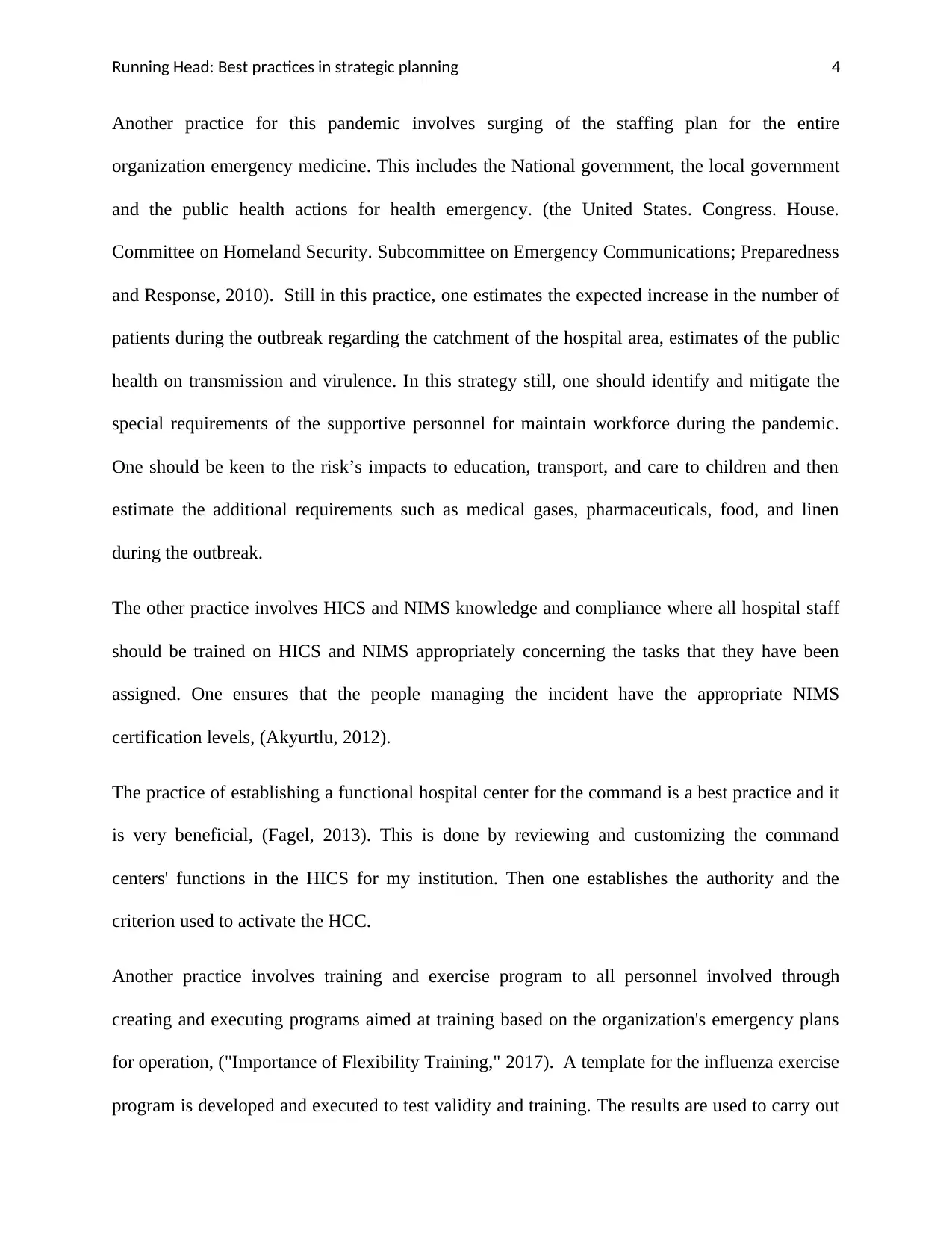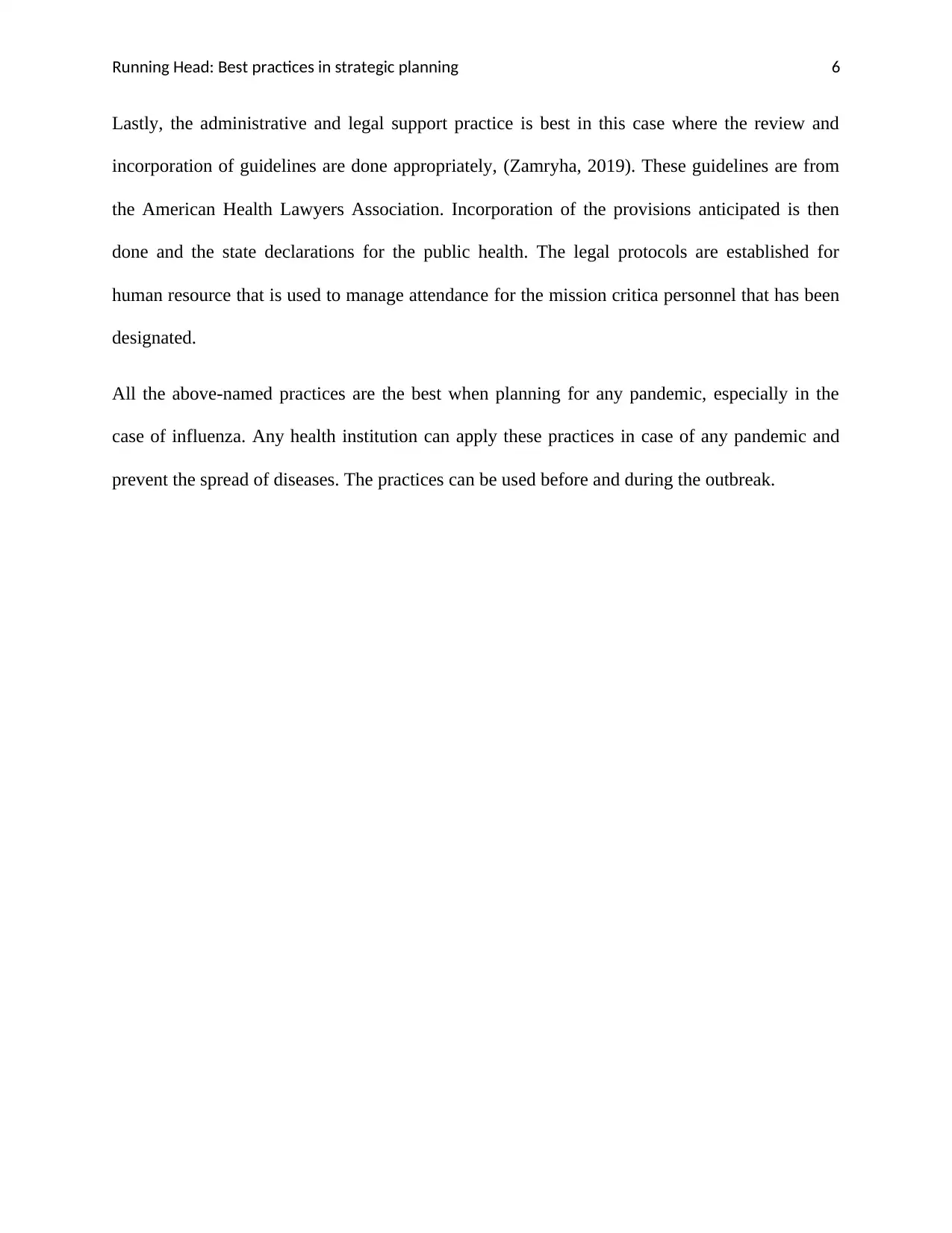Best Practices in Strategic Planning for Pandemic Influenza Outbreaks
VerifiedAdded on 2022/09/09
|8
|1762
|20
Report
AI Summary
This report examines the best practices in strategic planning for pandemic influenza outbreaks, emphasizing the importance of proactive measures in the face of potential health crises. It explores the strategic planning process, including establishing mission statements, goals, and action plans to respond effectively to challenges. The report highlights the significance of national health strategies in providing direction for improving public health and details essential actions for healthcare professionals, government agencies, and the general public to manage influenza outbreaks. Key strategies discussed include training emergency managers, developing emergency operations plans, surging staffing, adhering to HICS and NIMS protocols, establishing functional hospital command centers, implementing training and exercise programs, ensuring appropriate PPE, screening staff, enhancing facility security, and providing administrative and legal support. The report emphasizes the need for preparedness both before and during an outbreak, offering practical guidance for health institutions to mitigate the spread of diseases and protect healthcare infrastructure.

Running Head: Best practices in strategic planning 1
Best practices in strategic planning
Student’s Name
Institution
Date
Best practices in strategic planning
Student’s Name
Institution
Date
Paraphrase This Document
Need a fresh take? Get an instant paraphrase of this document with our AI Paraphraser

Running Head: Best practices in strategic planning 2
Best practices in Strategic planning
According to Abraham, (2012), strategic planning is a process of establishing the direction for
business after looking at the current state to the future of the organization. It enables agencies or
organizations to come up with the mission statement, goals, values, vision and long term goals.
The action plan to reach all this is also written down. A strategic plan enables organizations to
respond to opportunities and challenges in the best way and on time. These organizations include
government agencies that must plan on how to counter public health issues. The government
needs to do future planning of some events which include the outbreak of diseases. This can only
be done through strategic planning.
In a national health strategy document, the government spells the country’s vision, its `
considerations towards budgetary and the actions that will lead to improved and
maintained citizen’s health. Through the document, the direction is provided for improving
people's health and it is also used in the planning process. The activities that strengthen the
health information systems are contained in the national health strategy, ("National Health
Strategy — MEASURE Evaluation,").
The outbreak of influenza could at a greater extent affect my agency because I must explore the
best practices needed for strategic planning to curb this disease. The strategic plan shall be used
by the organization to let the healthcare professionals, the government and the general public of
the probability that any emergency department should have to successfully manage the outbreak
of influenza.
These essential actions can be performed by professional associations the federal entities, public
health professionals at all levels and also hospital staff. The healthcare infrastructure is affected
Best practices in Strategic planning
According to Abraham, (2012), strategic planning is a process of establishing the direction for
business after looking at the current state to the future of the organization. It enables agencies or
organizations to come up with the mission statement, goals, values, vision and long term goals.
The action plan to reach all this is also written down. A strategic plan enables organizations to
respond to opportunities and challenges in the best way and on time. These organizations include
government agencies that must plan on how to counter public health issues. The government
needs to do future planning of some events which include the outbreak of diseases. This can only
be done through strategic planning.
In a national health strategy document, the government spells the country’s vision, its `
considerations towards budgetary and the actions that will lead to improved and
maintained citizen’s health. Through the document, the direction is provided for improving
people's health and it is also used in the planning process. The activities that strengthen the
health information systems are contained in the national health strategy, ("National Health
Strategy — MEASURE Evaluation,").
The outbreak of influenza could at a greater extent affect my agency because I must explore the
best practices needed for strategic planning to curb this disease. The strategic plan shall be used
by the organization to let the healthcare professionals, the government and the general public of
the probability that any emergency department should have to successfully manage the outbreak
of influenza.
These essential actions can be performed by professional associations the federal entities, public
health professionals at all levels and also hospital staff. The healthcare infrastructure is affected

Running Head: Best practices in strategic planning 3
and thus it must be protected to ensure that there is an emergency medical treatment. The
strategies should address the required operational planning to cure influenza H1N1 before and
during its outbreak.
National planning here is based on available information. It is challenging, realistic but not
predictive. Management strategy ACEP can be used to make sure that patients get the best care
possible and its members get the best professional responsibilities.to ensure that this pandemic is
managed effectively, there are best practices that can be used in strategic planning.
Some of these strategies in the include implementing and managing programs that aim at
prevention and vaccination, measuring and reporting coverage of vaccinations, addressing the
issues surrounding HCP vaccination employer requirements implementation, ("Strategies to
Achieve the Healthy People 2020 Annual Influenza Vaccine Coverage Goal for Health-Care
Personnel: Recommendations from the National Vaccine Advisory Committee," 2013).
The first practice is training an emergency manager who is designated the duty of leading the
H1N1 preparedness response. The manager must be aware of the community's emergency
preparedness, public health, and resource managers. He/she can establish authority and fulfil the
tasks of ACEP influenza surge preparedness assessment and also come up with an appropriate
community planning guide that is used in maintaining awareness of the health status of the
people, (Fagel, 2011).
The second practice is coming up with the emergency operations H1N1 plan through appointing
the hospital pandemic influenza planning group that is used in reviewing the emergency
operation plan of the hospital.
and thus it must be protected to ensure that there is an emergency medical treatment. The
strategies should address the required operational planning to cure influenza H1N1 before and
during its outbreak.
National planning here is based on available information. It is challenging, realistic but not
predictive. Management strategy ACEP can be used to make sure that patients get the best care
possible and its members get the best professional responsibilities.to ensure that this pandemic is
managed effectively, there are best practices that can be used in strategic planning.
Some of these strategies in the include implementing and managing programs that aim at
prevention and vaccination, measuring and reporting coverage of vaccinations, addressing the
issues surrounding HCP vaccination employer requirements implementation, ("Strategies to
Achieve the Healthy People 2020 Annual Influenza Vaccine Coverage Goal for Health-Care
Personnel: Recommendations from the National Vaccine Advisory Committee," 2013).
The first practice is training an emergency manager who is designated the duty of leading the
H1N1 preparedness response. The manager must be aware of the community's emergency
preparedness, public health, and resource managers. He/she can establish authority and fulfil the
tasks of ACEP influenza surge preparedness assessment and also come up with an appropriate
community planning guide that is used in maintaining awareness of the health status of the
people, (Fagel, 2011).
The second practice is coming up with the emergency operations H1N1 plan through appointing
the hospital pandemic influenza planning group that is used in reviewing the emergency
operation plan of the hospital.
⊘ This is a preview!⊘
Do you want full access?
Subscribe today to unlock all pages.

Trusted by 1+ million students worldwide

Running Head: Best practices in strategic planning 4
Another practice for this pandemic involves surging of the staffing plan for the entire
organization emergency medicine. This includes the National government, the local government
and the public health actions for health emergency. (the United States. Congress. House.
Committee on Homeland Security. Subcommittee on Emergency Communications; Preparedness
and Response, 2010). Still in this practice, one estimates the expected increase in the number of
patients during the outbreak regarding the catchment of the hospital area, estimates of the public
health on transmission and virulence. In this strategy still, one should identify and mitigate the
special requirements of the supportive personnel for maintain workforce during the pandemic.
One should be keen to the risk’s impacts to education, transport, and care to children and then
estimate the additional requirements such as medical gases, pharmaceuticals, food, and linen
during the outbreak.
The other practice involves HICS and NIMS knowledge and compliance where all hospital staff
should be trained on HICS and NIMS appropriately concerning the tasks that they have been
assigned. One ensures that the people managing the incident have the appropriate NIMS
certification levels, (Akyurtlu, 2012).
The practice of establishing a functional hospital center for the command is a best practice and it
is very beneficial, (Fagel, 2013). This is done by reviewing and customizing the command
centers' functions in the HICS for my institution. Then one establishes the authority and the
criterion used to activate the HCC.
Another practice involves training and exercise program to all personnel involved through
creating and executing programs aimed at training based on the organization's emergency plans
for operation, ("Importance of Flexibility Training," 2017). A template for the influenza exercise
program is developed and executed to test validity and training. The results are used to carry out
Another practice for this pandemic involves surging of the staffing plan for the entire
organization emergency medicine. This includes the National government, the local government
and the public health actions for health emergency. (the United States. Congress. House.
Committee on Homeland Security. Subcommittee on Emergency Communications; Preparedness
and Response, 2010). Still in this practice, one estimates the expected increase in the number of
patients during the outbreak regarding the catchment of the hospital area, estimates of the public
health on transmission and virulence. In this strategy still, one should identify and mitigate the
special requirements of the supportive personnel for maintain workforce during the pandemic.
One should be keen to the risk’s impacts to education, transport, and care to children and then
estimate the additional requirements such as medical gases, pharmaceuticals, food, and linen
during the outbreak.
The other practice involves HICS and NIMS knowledge and compliance where all hospital staff
should be trained on HICS and NIMS appropriately concerning the tasks that they have been
assigned. One ensures that the people managing the incident have the appropriate NIMS
certification levels, (Akyurtlu, 2012).
The practice of establishing a functional hospital center for the command is a best practice and it
is very beneficial, (Fagel, 2013). This is done by reviewing and customizing the command
centers' functions in the HICS for my institution. Then one establishes the authority and the
criterion used to activate the HCC.
Another practice involves training and exercise program to all personnel involved through
creating and executing programs aimed at training based on the organization's emergency plans
for operation, ("Importance of Flexibility Training," 2017). A template for the influenza exercise
program is developed and executed to test validity and training. The results are used to carry out
Paraphrase This Document
Need a fresh take? Get an instant paraphrase of this document with our AI Paraphraser

Running Head: Best practices in strategic planning 5
further exercises to improve the operation plan for emergencies and then re exercising is done.
Designing and implementing a special training for the affairs of the public through planned care
is important to those who need it during the training. Finally, on this practice, the public affairs
of are discussed together with the public health authorities where the time to make the public
aware is discussed. The ways of informing the public on how to access care and information
during the outbreak is reached at.
Another best practice for this pandemic involves appropriate PPE for the emergency of the
healthcare staff. This is done through consulting the national guidance on the right PPE to use
during the time of the influenza pandemic, estimating the PPE needs for multiple waves of
influenza, stick piling the appropriate quantities for PPE and updating and training the medical
personnel on the use of PPE, (McIsaac, 2010).
The other strategy involves screening the staff for illness through developing of protocols for
staff screening and the criteria to be used to do dismissal from work when the staff is termed
symptomatic, ("CDC Works 24/7," 2019) The staff found to be at a high risk of the
complications of influenza are reassigned duty or considered furlough and then the criteria to be
used for the staff to return to work and the process is developed.
Another practice is about the enhanced security of the facility and the crowd. In this case, a
criterion is developed and plan for implementing high-level security and crowd management
even through the lockdown of the facility. A plan is developed and criteria to be used to limit
visitors, the establishment of a memorandum of understanding with the law agents and others
that ensure the security of institutions.
further exercises to improve the operation plan for emergencies and then re exercising is done.
Designing and implementing a special training for the affairs of the public through planned care
is important to those who need it during the training. Finally, on this practice, the public affairs
of are discussed together with the public health authorities where the time to make the public
aware is discussed. The ways of informing the public on how to access care and information
during the outbreak is reached at.
Another best practice for this pandemic involves appropriate PPE for the emergency of the
healthcare staff. This is done through consulting the national guidance on the right PPE to use
during the time of the influenza pandemic, estimating the PPE needs for multiple waves of
influenza, stick piling the appropriate quantities for PPE and updating and training the medical
personnel on the use of PPE, (McIsaac, 2010).
The other strategy involves screening the staff for illness through developing of protocols for
staff screening and the criteria to be used to do dismissal from work when the staff is termed
symptomatic, ("CDC Works 24/7," 2019) The staff found to be at a high risk of the
complications of influenza are reassigned duty or considered furlough and then the criteria to be
used for the staff to return to work and the process is developed.
Another practice is about the enhanced security of the facility and the crowd. In this case, a
criterion is developed and plan for implementing high-level security and crowd management
even through the lockdown of the facility. A plan is developed and criteria to be used to limit
visitors, the establishment of a memorandum of understanding with the law agents and others
that ensure the security of institutions.

Running Head: Best practices in strategic planning 6
Lastly, the administrative and legal support practice is best in this case where the review and
incorporation of guidelines are done appropriately, (Zamryha, 2019). These guidelines are from
the American Health Lawyers Association. Incorporation of the provisions anticipated is then
done and the state declarations for the public health. The legal protocols are established for
human resource that is used to manage attendance for the mission critica personnel that has been
designated.
All the above-named practices are the best when planning for any pandemic, especially in the
case of influenza. Any health institution can apply these practices in case of any pandemic and
prevent the spread of diseases. The practices can be used before and during the outbreak.
Lastly, the administrative and legal support practice is best in this case where the review and
incorporation of guidelines are done appropriately, (Zamryha, 2019). These guidelines are from
the American Health Lawyers Association. Incorporation of the provisions anticipated is then
done and the state declarations for the public health. The legal protocols are established for
human resource that is used to manage attendance for the mission critica personnel that has been
designated.
All the above-named practices are the best when planning for any pandemic, especially in the
case of influenza. Any health institution can apply these practices in case of any pandemic and
prevent the spread of diseases. The practices can be used before and during the outbreak.
⊘ This is a preview!⊘
Do you want full access?
Subscribe today to unlock all pages.

Trusted by 1+ million students worldwide

Running Head: Best practices in strategic planning 7
References
Abraham, S. C. (2012). Strategic Planning: A Practical Guide for Competitive Success. West
Yorkshire, England: Emerald Group Publishing.
Akyurtlu, A. (2012). A Quantum Electronics Approach to Optical Negative Index
Metamaterials (NIMs): Homogeneous NIMs in the Solid State. doi:10.21236/ada563721
CDC Works 24/7. (2019, December 16). Retrieved from https://www.cdc.gov/
Fagel, M. J. (2011). Principles of Emergency Management: Hazard Specific Issues and
Mitigation Strategies. Boca Raton, FL: CRC Press.
Fagel, M. J. (2013). Crisis Management and Emergency Planning: Preparing for Today's
Challenges. Boca Raton, FL: CRC Press.
The Importance of Flexibility Training. (2017). Anatomy: A Pressing Concern in Exercise
Physiology, 78-90. doi:10.2174/9781681084695117010009
Kilbourne, E. (2012). Influenza. Berlin, Germany: Springer Science & Business Media.
McIsaac, J. H. (2010). Hospital Preparation for Bioterror: A Medical and Biomedical Systems
Approach. Amsterdam, Netherlands: Elsevier.
National Health Strategy — MEASURE Evaluation. (n.d.). Retrieved from
https://www.measureevaluation.org/his-strengthening-resource-center/resources/
national-health-strategy
Strategies to Achieve the Healthy People 2020 Annual Influenza Vaccine Coverage Goal for
Health-Care Personnel: Recommendations from the National Vaccine Advisory
References
Abraham, S. C. (2012). Strategic Planning: A Practical Guide for Competitive Success. West
Yorkshire, England: Emerald Group Publishing.
Akyurtlu, A. (2012). A Quantum Electronics Approach to Optical Negative Index
Metamaterials (NIMs): Homogeneous NIMs in the Solid State. doi:10.21236/ada563721
CDC Works 24/7. (2019, December 16). Retrieved from https://www.cdc.gov/
Fagel, M. J. (2011). Principles of Emergency Management: Hazard Specific Issues and
Mitigation Strategies. Boca Raton, FL: CRC Press.
Fagel, M. J. (2013). Crisis Management and Emergency Planning: Preparing for Today's
Challenges. Boca Raton, FL: CRC Press.
The Importance of Flexibility Training. (2017). Anatomy: A Pressing Concern in Exercise
Physiology, 78-90. doi:10.2174/9781681084695117010009
Kilbourne, E. (2012). Influenza. Berlin, Germany: Springer Science & Business Media.
McIsaac, J. H. (2010). Hospital Preparation for Bioterror: A Medical and Biomedical Systems
Approach. Amsterdam, Netherlands: Elsevier.
National Health Strategy — MEASURE Evaluation. (n.d.). Retrieved from
https://www.measureevaluation.org/his-strengthening-resource-center/resources/
national-health-strategy
Strategies to Achieve the Healthy People 2020 Annual Influenza Vaccine Coverage Goal for
Health-Care Personnel: Recommendations from the National Vaccine Advisory
Paraphrase This Document
Need a fresh take? Get an instant paraphrase of this document with our AI Paraphraser

Running Head: Best practices in strategic planning 8
Committee. (2013, January). Retrieved from
https://www.ncbi.nlm.nih.gov/pmc/articles/PMC3514716/
United States. Congress. House. Committee on Homeland Security. Subcommittee on
Emergency Communications; Preparedness and Response. (2010). PKEMRA
Implementation: An Examination of FEMA's Preparedness and Response Mission :
Hearing Before the Subcommittee on Emergency Communications, Preparedness, and
Response of the Committee on Homeland Security, House of Representatives, One
Hundred Eleventh Congress, First Session, March 17, 2009.
Zamryha, A. V. (2019). “Administrative service-based nature” as a feature of public
administration activities in administrative and legal support of business activity in
ukraine. Legal position, 3, 31-36. doi:10.32836/2521-6473-2019-3-31-36
Committee. (2013, January). Retrieved from
https://www.ncbi.nlm.nih.gov/pmc/articles/PMC3514716/
United States. Congress. House. Committee on Homeland Security. Subcommittee on
Emergency Communications; Preparedness and Response. (2010). PKEMRA
Implementation: An Examination of FEMA's Preparedness and Response Mission :
Hearing Before the Subcommittee on Emergency Communications, Preparedness, and
Response of the Committee on Homeland Security, House of Representatives, One
Hundred Eleventh Congress, First Session, March 17, 2009.
Zamryha, A. V. (2019). “Administrative service-based nature” as a feature of public
administration activities in administrative and legal support of business activity in
ukraine. Legal position, 3, 31-36. doi:10.32836/2521-6473-2019-3-31-36
1 out of 8
Related Documents
Your All-in-One AI-Powered Toolkit for Academic Success.
+13062052269
info@desklib.com
Available 24*7 on WhatsApp / Email
![[object Object]](/_next/static/media/star-bottom.7253800d.svg)
Unlock your academic potential
Copyright © 2020–2025 A2Z Services. All Rights Reserved. Developed and managed by ZUCOL.





